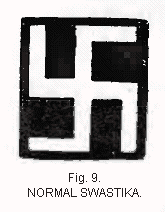

The Swastika
Dispersion of the Swastika
We also see a Swastika (turned to the left) scratched on two terra cotta bowls of the Pueblo Indians of New Mexico, preserved in the ethnological section of the Royal Museum at Berlin.
G. Nordenskiöld, (2) in the report of his excavations among the ruined pueblos of the Mesa Verde, made in southwestern Colorado during the summer of
 1891,
tells of the finding of numerous specimens of the Swastika. In pl. 23,
fig. 1, he represents a large, shallow bowl in the refuse heap at the
"Step House." It was 50 centimeters in diameter, of rough execution,
gray in color, and different inform and design from other vessels from
the cliff houses. The Swastika sign (to the right) was in its center,
and made by lines of small dots. His pl. 27, fig. 6, represents a bowl
found in a grave (g on the plan) at "step House." Its
decoration inside was of the usual type, but the only decoration on the
outside consisted of a Swastika, with arms crossing at right angles and
ends bent at the right, similar to fig. 9. His pl. 18, fig. 1, represented
a large bowl found in Mug House. Its decoration consisted in part of a
Swastika similar in form and style to the Etruscan gold "bulla,"
fig. 188 in this paper. Certain specimens of pottery from the pueblos
of Santa Clara and St. Ildefonso, deposited in the U. S. National Museum
(Department of Ethnology), bear Swastika marks,
1891,
tells of the finding of numerous specimens of the Swastika. In pl. 23,
fig. 1, he represents a large, shallow bowl in the refuse heap at the
"Step House." It was 50 centimeters in diameter, of rough execution,
gray in color, and different inform and design from other vessels from
the cliff houses. The Swastika sign (to the right) was in its center,
and made by lines of small dots. His pl. 27, fig. 6, represents a bowl
found in a grave (g on the plan) at "step House." Its
decoration inside was of the usual type, but the only decoration on the
outside consisted of a Swastika, with arms crossing at right angles and
ends bent at the right, similar to fig. 9. His pl. 18, fig. 1, represented
a large bowl found in Mug House. Its decoration consisted in part of a
Swastika similar in form and style to the Etruscan gold "bulla,"
fig. 188 in this paper. Certain specimens of pottery from the pueblos
of Santa Clara and St. Ildefonso, deposited in the U. S. National Museum
(Department of Ethnology), bear Swastika marks,  chiefly
of the ogee form. (3)
chiefly
of the ogee form. (3)The Navajoes. --- Dr. Washington Matthews, U. S. A., than whom no one has done better, more original, nor more accurate anthropologic work in America, whether historic or prehistoric, has kindly referred me to his memoir of the Fifth Annual Report of the Buerau of Ethnology, comprising 82 pages, with 9 plates and 9 figures, entitled "The Mountain Chant; a Navajo ceremony." It is descriptive of one of a number of ceremonies practiced by the shamans or medicine men of the Navajo Indians, New Mexico. The ceremony is public, although it takes place during the night. It lasts for nine days and is called by the Indians "dsilyídje qaçál" may allude to mountains in general, to the Carrizo Mountains in particular, to the place in the mountains where the prophet (originator of these ceremonies) dwelt, to his name, or to all of these combined. "Qaçál" means a sacred song or a collection of sacred songs. Dr. Matthews describes at length the myth which is the foundation of this ceremony, which must be read to be appreciated, but may be summarized thus: An Indian family, consisting of father, mother, two sons, and two daughters, dwelt in ancient times near the Carrizo Mountains. They lived by hunting and trapping; but the
ENDNOTES:
1. "Troja," p. 123. [Back]
2. "The Cliff Dwellers of the Mesa Verde, Southwestern Colorado," P. A. Norstedt & Son, Chicago, 1893. Back
3. From letter of Mr. Walter Hough, Winslow, Ariz. "I send you two pieces of pottery [bearing many ogee Swastikas] from the ruins near here formerly inhabited by the Moki. Many of the bowls which we have found in this ruin had the Swastika as a major motifin the decoration."
See also The Archæologhist, III, No. 7, p. 248. Back
H. Mis. 90, pt. 2 ------ 57
<< Previous Page Next Page >>
© 2004-2007 Northvegr.
Most of the material on this site is in the public domain. However, many people have worked very hard to bring these texts to you so if you do use the work, we would appreciate it if you could give credit to both the Northvegr site and to the individuals who worked to bring you these texts. A small number of texts are copyrighted and cannot be used without the author's permission. Any text that is copyrighted will have a clear notation of such on the main index page for that text. Inquiries can be sent to info@northvegr.org. Northvegr™ and the Northvegr symbol are trademarks and service marks of the Northvegr Foundation.

|